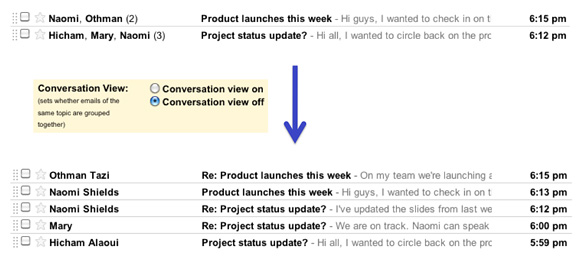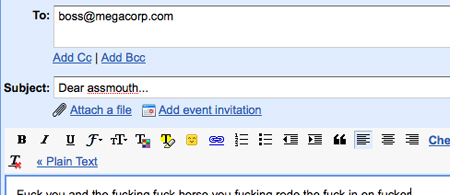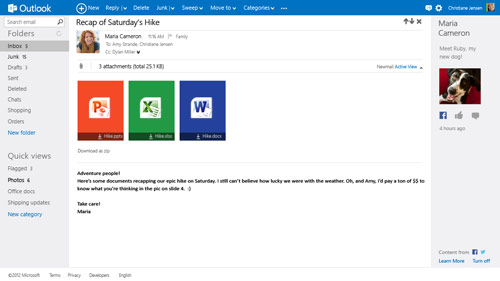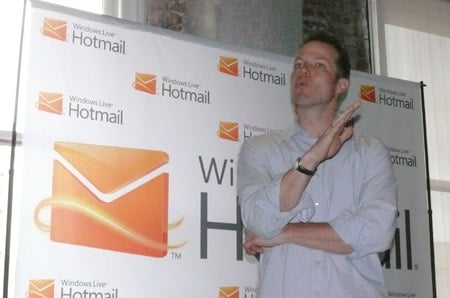Original URL: https://www.theregister.com/2014/04/01/gmail_tenth_anniversary/
That's it, we're all really OLD: Google's Gmail is 10 ALREADY
They just wanted to beat off Hotmail, AOL and Yahoo!
Posted in Software, 1st April 2014 10:01 GMT
Gmail shook up the world of free web email in the mid-2000s, but 10 years after going public in 2004, Google’s service offers much more than simply firing emails around the world.
When Google unveiled Gmail on 1 April, 2004, the company’s co-founders reckoned the service was just its way of making email better. Gmail was, we were assured, simply the product of an engineer’s free time (each Googler was allowed to spend 20 per cent of their working week toiling away on personal projects).
Given the state of the prevailing free web email services at the time, beating the state of the art from Microsoft, Yahoo! and AOL wasn’t a taxing exercise.
A decade later and the number of Gmail subscribers ranges between 289 million and 425 million and it is either the biggest or third biggest, depending on who you believe.
Whether it’s 289 million or 425 million isn’t the point – or even the worst part/best bit (depending on who you are). What is the point, is that Gmail clawed out several million users from a standing start of zero, and did this years after the main mail-pushers had already staked out millions of users between them.

Threading: one of the features that sold Gmail to the masses
If Gmail had simply stayed a free web email service for consumers, that would have been the end of this story – but it didn’t. It succeeded in doing something neither Hotmail, Yahoo! Mail or AOL succeeded in doing – and ate up business customers, too.
The breezy new features and slick services in Gmail were popular with consumers. And we all know what consumers are inside the hours of 9am and 5pm, Monday to Friday: they are employees.
That’s why the mail service is where it is today: with Microsoft the last of the Big Three that's still fighting to keep Gmail as an email platform and collaboration stack out of the accounts it owns.
Last year, Google claimed it had five million businesses on its Gmail-related Google Apps, with Google partners busily installing Gmail and apps on tens of thousands of seats.
You've got Gmail
Back in 2004, Google had arrived a little late to the field of free web email. Gmail was launched seven years after the company was incorporated in 1997 and it went up against Microsoft’s Hotmail, Yahoo! Mail and AOL – the latter famous even in films for giving us the catchphrase of '90s romcom You’ve Got Mail. “You’ve Got Mail” was the “Just Google it” of its day.
Remember 2009's "undo" option?


According to Larry Page, Gmail was a response to an email from a frustrated Google fan.
“She kvetched about spending all her time filing messages or trying to find them," Page said. "And when she’s not doing that, she has to delete email like crazy to stay under the obligatory four megabyte limit. So she asked, ‘Can’t you people fix this?’
"Gmail solves all of my communication needs. It’s fast and easy and has all the storage I need. And I can use it from anywhere. I love it!"
What “she”, and we, got was buckets of storage, improved search and near-watertight spam protection.
Gmail came with 1GB storage, so you didn’t have to constantly prune your inbox to stay under the provider’s limit – which in the case of Microsoft was a measly 250MB. Neither did Google deactivate your account following period of inactivity, as Microsoft did.
But Gmail didn’t merely fill in the gaps left by those who saw free email as an annoying obligation – a way to make a little free change off the user.
It offered better features in more areas – features the incumbents were forced to adopt.
Killer features
These features included:
- Message threading – grouping related emails as “conversations”, which meant you didn’t have to wade through your inbox to find separate but related emails pertaining to a discussion of topic.
- Google search – allowing the user to find messages more quickly and without needing to build a Byzantine complex of folders to organise their messages
- Spam filtering – where the software learned to recognise the characteristics of unsolicited emails. It was much cleverer than the black-and-white lists that its rivals kept of those hawking fake Viagra and cheap printer cartridges.
- Gmail was also mobile-ready from the start and worked in most browsers by default.
Google didn’t exactly launch Gmail straight away: you had to be invited to a closed beta test program. Then the masses were admitted. The preview was on 1 April.
The incumbents soon understood that Google was on to something. Two months after Gmail launched, Redmond upped the Hotmail inbox from 2MB to 250MB. But Microsoft's business model didn’t change – it would still charge you extra for small gobs of extra storage - $19.95 a year for an extra 10MB to $59.95 for up to 100MB for Hotmail. Microsoft also flogged "premium" options.
It was almost like Microsoft wanted you to go to Google.
Have some 'Office', folks
In 2006, Google took free up a gear by launching Docs and Spreadsheets, the online alternatives to Microsoft's paid-for Word and Excel on the PC. In 2011, Mountain View rolled out its shared work space, Drive.
A decade on, those installing and customiSing Docs and Drive for businesses point to the lubricating effect of Gmail.
Google partner Cloud Sherpas, which also runs a Salesforce practice, said it’s easy to find Gmail champions in companies to convert Hotmail and AOL users.
It reckons more than half of the staff at companies it goes into are already familiar with Gmail, which helps grease the skids on Google Apps.

Outlook.com hustled to compete last year with attachments and Facebook integration
Doug Shepard, president of Cloud Sherpas' Google business unit said: “The employees are familiar with Gmail from their personal life. It makes it easier for an organisation to say they are moving to this tool.”
Cloud Sherpas claims 2,000 enterprise users, and says its business is growing, to the point that it has rolled out 65,000 seats of Google Docs to staff. Its clients include John Lewis.
Rolling out something like Microsoft Exchange and Office – even the webby Office 365 - would have been impossible because of licensing fee charged by Microsoft.
This is dangerous, because it means Google has become a strategic email and collaboration platform not merely a provider of free web email and some spreadsheets. There’s no way companies that are standardising on Google would have done so without the sign-off of top management.
“We are called in from a variety of lines in a company - sales staff, CFO, executives looking for culture change," Shepard said. "The decision is a technical decision from the CIO’s office but the final decision to change the one application that every employee touches, messaging, that is a CEO-level decision. That is 100 per cent of the time.”
Alex Gawley, the Gmail product manager, told The Register: “Now when we talk to businesses it’s normalised they want to move their mail and calendar system to the cloud and next level is to talk about instant collaboration in Docs and groups.”

Microsoft's Chris Jones previews the "new" Hotmail in 2010
Microsoft upped Hotmail’s inbox size but it missed the larger threat that Gmail was becoming to its on-prem email and collaboration business. Microsoft had been the new alternative to Lotus Notes or Novell's Groupwise, with Redmond selling the on-prem Office, Outlook and Exchange software stack. Now Microsoft was under attack.
Microsoft's response has been slow and mixed in coming: it paid sales people and partners a bounty to rip out Gmail in boxes for Exchange in 2010, has been pushing the Scroogled ads campaign to put the fear into people that Mountain View is scanning their inboxes to sell them personalised ads, and it's offered easy email migration tools - a tactic dating from the old Microsoft Exchange versus Lotus Notes days.
The flip side of the coin has been prompting Business Productivity Online Suite (BPOS), which became Office 365 in 2011, and re-branding Hotmail to as Outlook.com in the middle of 2012.
Unveiling Gmail in 2004, Google’s chiefs gave the impression it was nothing more than a humble response to a cry for help from a frustrated user. They claimed it was the product of Google’s 20-per-cent rule. But events suggest Google had a bigger strategy and that Gmail was just the beginning.
That strategy was to become more than a simple one-act play, a search engine, by becoming more relevant to people’s lives as a communications platform.
What's next for Gmail?
Gmail hasn’t changed too much in 10 years: there’s been a new inbox with tabbed folders for different types of communication and yellow arrows to help highlight emails in the main inbox. Neither have seemed particularly exciting or successful, in fact arrows seems a bit pointless. We've also had native clients for smartphones and tablets, so you aren't stuck in the browser.
Meanwhile, email as a medium has been challenged by the rise of social networks with their own in-network messaging. Google has tried its hand here with Google+, and has tried to go beyond email with Wave. The latter was canned.
It seems like the email medium is stuck where it is, possibly on its back foot – given Facebook has more than one billion active monthly users.
Gawley reckons reports of the death of the email medium are greatly exaggerated. “We don’t see any evidence that email is dead,” he said.
He sees Gmail’s future as an inbox that's a hub for different messaging systems. “We see a pretty healthy growing ecosystem. We are interested in how we build on that and extend on that. Mobile networks and messaging have their own use cases. I see a future for all of them.”
Meanwhile, there’s Groupwise, Notes and even Exchange shops to target. If the medium ain't broke, it seems, don't try to fix it. Hang on... ®